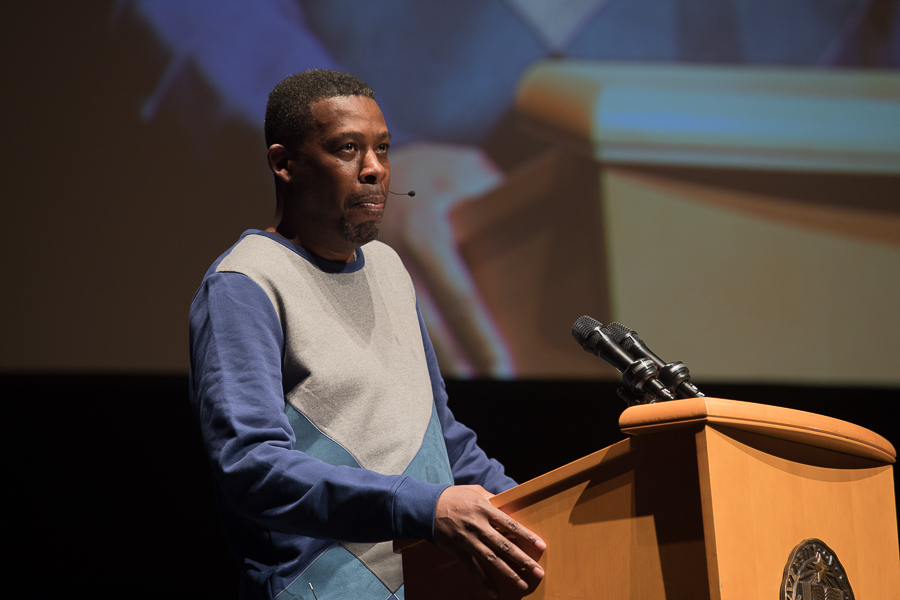
GZA of the Wu-Tang Clan visits UC Davis to speak about science, music
Hip-hop icon and lyricist GZA visited the Mondavi Center on May 21 for the final Chancellor’s Colloquium of the quarter. The speaking event, titled “Dark Matter: An Evening of Songs and Science,” was a collaboration between the Chancellor’s Office, the John Muir Institute of the Environment and One Climate.
“We wanted to bring a new, fresh perspective on science communication and engagement — reaching students who have been traditionally overlooked,” said Benjamin Houlton, the director of the JMIE, in an email interview. “GZA’s message of empowerment through scientific thinking, using hip-hop as a vehicle for teaching science, is a wonderful example of the kind of ‘uncommon’ solutions that are needed to drive innovation in the 21st century.”
Houlton introduced the One Climate initiative during his remarks. One Climate is an interdisciplinary project among many of the innovative departments at UC Davis. The goal is to win the battle against changing climate by harnessing all the knowledge available on campus.
“We saw GZA, specifically, as a great way to help us launch our One Climate initiative because he’s a great way to showcase hip-hop as a vehicle for science,” said Sara Nichols, the associate director of strategic initiatives at the JMIE.
GZA told the audience he has been working on an album called “Dark Matter” — “a cosmic journey through the universe.” The songs would be complex scientific topics told in the lyrics of hip-hop, helping to keep alive the natural curiosity in the hearts of youth. GZA is one of the partners of Chris Emdin’s Science Genius, an educational endeavor focused on “utilizing the power of hip-hop music and culture to introduce youth to the wonder and beauty of science.”
“GZA’s Science Genius and his talks on ‘Dark Matter’ focus on the art of rap and the culture of hip-hop as a key to engaging youth in STEM,” Nichols said. “It’s not just about the science — it’s about using interdisciplinary subjects to engage students.”
To begin the program, members of Sacramento Area Youth Speaks performed spoken word poems. Poems of poverty, community violence, police brutality and struggling with personal identities were contrasted with declarations of talent, acceptance and empowerment.
“As Audre Lorde proclaimed, ‘Poetry is not a luxury,’” said Vajra Watson, the director of the Office of Research and Policy for Equity and the founder of SAYS. “At SAYS, we view critical literacy practices and the literary arts as an action, a process of reclaiming oneself in relation to the world. An education that empowers [and] fosters opportunities for students to become the authors of their own lives and agents of change.”
SAYS works with students who feel disconnected or left out of the education curriculum. When students are bored in the classroom — or when the chemistry lesson in the classroom feels so trivial compared to the poverty and injustice at home or in the greater community — students can struggle or be left behind. Using music and poetry could reach these students.
“Science communication is really about listening, learning and using analogies and metaphors for greater insight and impact,” Houlton said. “It takes time and dedication. There are many different ways to communicate science, and not all of them are equally effective. I like to communicate through values and personal experience and tap into discovery and imagination, which are, to my mind, universal traits of humanity.”
GZA told the assembled crowd that he was “a scientist by nature, not by trade.” As a child, he was fascinated by electricity and was curious about its properties. He recalled static shock from carpets at home. A cousin who had plugged a kitchen utensil into an electrical socket was burned, but GZA’s family said it would have been worse if the cousin wasn’t wearing shoes with rubber soles. Another story was about being a youth in a Staten Island classroom and being asked to write something on the chalkboard. Every time he would grab a piece of chalk from the tray, he would receive a shock and was curious what caused the phenomenon.
“Teachers could leverage hip-hop, but first they have to attune themselves to the music and attune themselves to what their students love to listen to and why,” Watson said. “Moreover, many students fathom the science of life — as GZA discussed with his friend who survived an electrocution because he had rubber-soled shoes on — but we rarely engage urban youth as natural scientists. Instead, we try and convert them to the sciences and this mismatch often fails to genuinely excite them about their own genius.”
Educating students can take many forms. Using art and music to share the wonders and mysteries of science is one way to reach students and inspire them. As GZA said about the universal language of the world, “All living things have music within them.”
Written by: George Ugartemendia — science@theaggie.org



